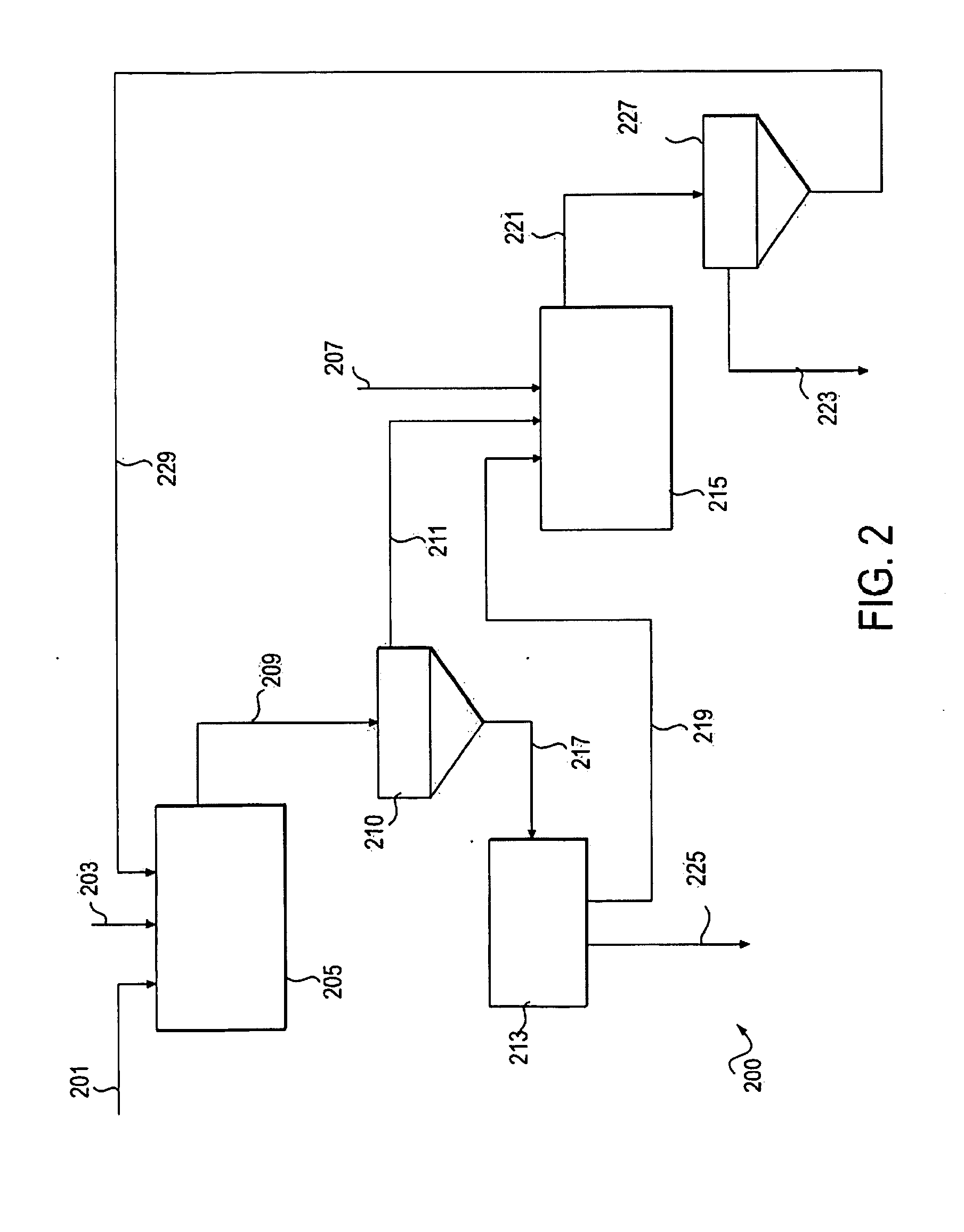Method and apparatus for removing arsenic from a solution
a technology of arsenic removal and arsenic solution, which is applied in the direction of crystal growth process, alkali metal halide purification, water/sewage treatment by ion exchange, etc., can solve the problems of reducing or removing arsenic, and the cost of stabilization procedures is quite high
- Summary
- Abstract
- Description
- Claims
- Application Information
AI Technical Summary
Benefits of technology
Problems solved by technology
Method used
Image
Examples
example 1
Single Treatment of Caustic As-Containing Mining Waste Solution
[0041]These experiments were conducted to determine the surface loading:volume ratio necessary to treat the caustic As-containing solution. The caustic As-containing solution consisted of 5-7 g / L As (III), 20 g / L Na2CO3, 4 g / L Sulfate, 4 mg / L Ni, and 1 mg / L Cu. The pH of the solution was approximately 10.5. The fixing agent used in these experiments was a high surface area ceria, prepared by thermally decomposing cerium carbonate to CeO2 at 300° C. in a muffle furnace with adequate exposure to air.
[0042]Single treatment experiments were run using 200 mL of caustic As-containing solution at approximately 75° C. and adding between 3-20 g of the thermally decomposed cerium carbonate. Under test conditions, the ceria surface became saturated at a loading of 80 mg (As) / g (Ce). When more than 10 g of ceria was added, the arsenic concentration dropped below 0.2% and the surface was no longer able to be loaded to the saturation ...
example 2
Two-Stage Counter-Current Treatment of Caustic As-Containing Solution
[0044]A caustic As-containing solution was prepared by adding 10 g NaAsO2, 20 g Na2CO3, 1 mL of 1000 ppm copper nitrate standard, 0.4 mL of 10,000 ppm nickel nitrate standard to 800 mL DI water. The caustic As-containing solution was then diluted to a full liter and the pH was titrated down to 10.5 using concentrated HCl. With the addition of the nickel sulfate and copper sulfate, a majority of nickel and copper precipitated out, due to the high pH of the caustic solution. The resulting caustic As-containing solution consisted of 5 g / L As (III), 20 g / L Na2CO3, 300 μg / L Ni, and 300 μg / L Cu. The fixing agent was again a high surface area ceria prepared by thermally decomposing cerium carbonate to CeO2 at 300° C. in a muffle furnace with adequate exposure to air.
[0045]The two stage counter-current procedure was carried as follows:[0046]Cycle 1 / Stage 1: 12 g of 300 thermally decomposed cerium carbonate was added to 200...
example 3
Two-Stage Counter-Current Treatment of Acidic As-Containing Solution
[0053]The two-stage counter-current treatment procedure used in Example 2 was also applied to an acidic As-containing solution containing 35 ppm As (III). The acidic solution was prepared by adding 18.72 mL of 5770 ppm As (III), 1074.3 g Nickel (II) Sulfate, 250 g NaCl, 0.63 g cobalt (II) sulfate, 6 mL of 1000 ppm lead nitrate standard, and 1.5 mL of 1000 ppm copper nitrate standard to 2 L of deionized water. The solution was then diluted to 3 L, to give a pH of approximately 2.
[0054]The acidic As-containing solution was then treated with thermally decomposed cerium carbonate using the two stage counter-current procedure. The process treated a liter of the acidic As-containing solution with 0.8 g of ceria. Some dissolution of the cerium fixing agent was observed and measured along with the arsenic concentration of the treated solutions. The results are provided in Table 3. In all cases, the twice treated solutions h...
PUM
| Property | Measurement | Unit |
|---|---|---|
| temperature | aaaaa | aaaaa |
| pH | aaaaa | aaaaa |
| alkaline | aaaaa | aaaaa |
Abstract
Description
Claims
Application Information
 Login to View More
Login to View More - R&D
- Intellectual Property
- Life Sciences
- Materials
- Tech Scout
- Unparalleled Data Quality
- Higher Quality Content
- 60% Fewer Hallucinations
Browse by: Latest US Patents, China's latest patents, Technical Efficacy Thesaurus, Application Domain, Technology Topic, Popular Technical Reports.
© 2025 PatSnap. All rights reserved.Legal|Privacy policy|Modern Slavery Act Transparency Statement|Sitemap|About US| Contact US: help@patsnap.com


